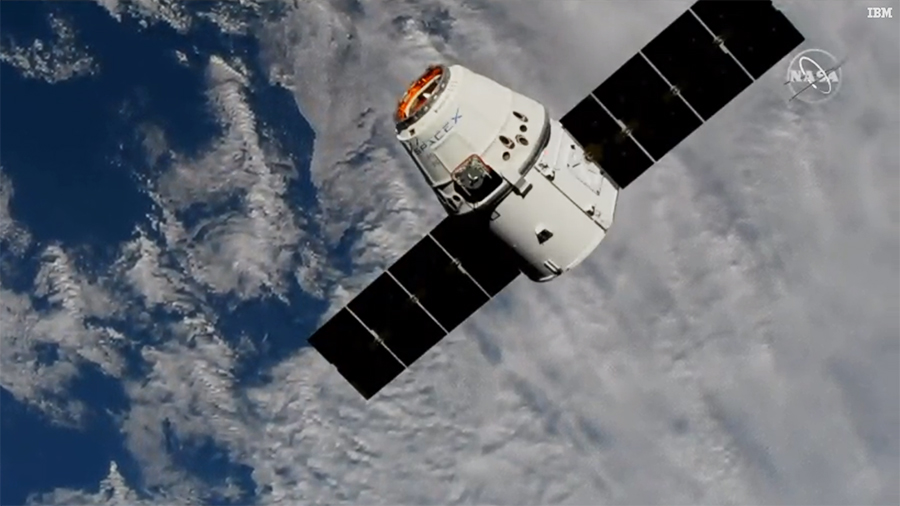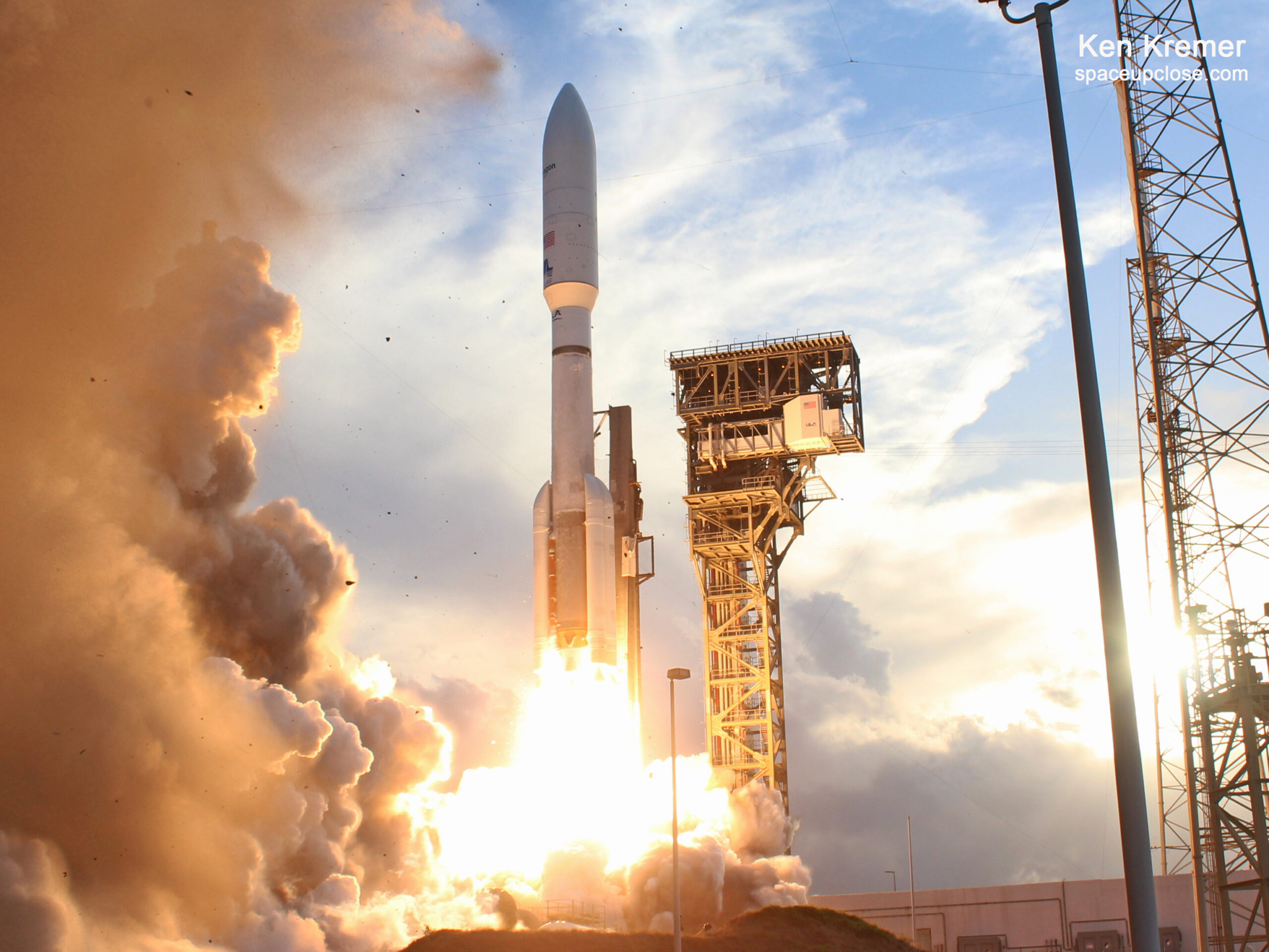
For SpaceUpClose.com & RocketSTEM
KENNEDY SPACE CENTER/CAPE CANAVERAL AIR FORCE STATION, FL – Astronauts have captured a SpaceX Dragon cargo ship with the robotic arm for the final time after the vessel arrived at the International Space Station (ISS) this morning, Monday, March 9 two days after blastoff from the Florida Space Coast.
The final first generation SpaceX Dragon 1 spacecraft reached the vicinity of the orbiting outpost around 6 a.m. this morning on its 20th NASA contracted resupply mission and a cargo delivery run carrying over two tons of NASA science and supplies for the multinational three person Expedition 62 crew living and working aboard
After maneuvering within reach and while traveling some 262 miles (400 km) over the Northeast Pacific near Vancouver, British Columbia, Expedition 62 Flight Engineer Jessica Meir of NASA grappled Dragon at 6:25 a.m. EDT using the space station’s 57 foot long robotic arm Canadarm2.
CAPTURED! @Astro_Jessica and @AstroDrewMorgan have successfully captured the @SpaceX Dragon at the @Space_Station at 6:25am ET! Installation coverage will begin at 8am ET. pic.twitter.com/64tP1oTH7U
— NASA (@NASA) March 9, 2020
Future Dragon spaceships comprising of the upgraded SpaceX Dragon 2 version to be used for launching both cargo and astronaut crews will dock autonomously at the station – with no need for astronauts to intervene and capture the visiting vessels.
NASA astronaut Andrew Morgan acting as a backup while the pair worked at a robotics work station inside the 7 windowed domed Cupola module.
With the astronauts robotic arm work now complete, ground controllers then took over remotely to send commands to carry out and complete the robotic berthing and installation of Dragon onto the bottom of the station’s Harmony module at 8:18 a.m. ET.
Installation complete! After a two-day journey to the @Space_Station, the @SpaceX #Dragon was successfully installed at 8:18 am ET, where it will remain until April. pic.twitter.com/dO3qAcmd4r
— NASA (@NASA) March 9, 2020
The entire arrival and berthing operation was carried live on NASA Television online at www.nasa.gov/live.
Dragon will remain attached to the ISS about 30 days until early April.

Dragon will deliver more than 4,300 pounds of NASA cargo and science investigations, including a new science facility named Bartolomeo built by ESA (European Space Agency) and Airbus that is scheduled to be installed to the outside of the station during a spacewalk this spring.
Overall SpaceX has delivered over 94,000 pounds of cargo up mass to the ISS during the life of Dragon 1 since 2012 with 19 successful mission and 1 failure during the CRS-7 launch in 2015. Dragon has returned over 70,000 pounds of science experiments and cargo back to Earth.
The SpaceX Dragon CRS-20 cargo ship streaked to space on a fantastic midnight launch and cargo deliver run carrying over two tons of NASA science and supplies to the International Space Station (ISS) Friday, March 6 from the Florida Space Coast.

Furthermore the SpaceX team accomplished the 50th landing of a Falcon 9 first stage back at the Cape some eight and a half minutes after liftoff – that thundered with sonic booms and set off car alarms too !! – to the delight of hordes of spectators gathered here from around the world.
The SpaceX Dragon CRS-20 cargo spacecraft began its journey to the International Space Station after launching atop a ‘flight-proven’ at 11:50 p.m. EST Friday (0449 GMT Saturday) from Space Launch Complex 40 at Cape Canaveral Air Force Station in Florida.

This final Dragon 1 liftoff also marked the 3rd cargo Dragon to fly 3 missions – the maximum for which they are certified – on what counts as the final mission of the first generation Dragon 1 vessel which has been flying to the ISS since 2012.
The Dragon 1 will be replaced by the more advanced Dragon 2 to be used for both cargo and crew flights for astronauts.
Here are details from NASA about some of the scientific investigations Dragon is delivering:
New Facility Outside the Space Station
The Bartolomeo facility, created by ESA (European Space Agency) and Airbus, attaches to the exterior of the European Columbus Module. Designed to provide new scientific opportunities on the outside of the space station for commercial and institutional users, the facility offers unobstructed views both toward Earth and into space. Potential applications include Earth observation, robotics, material science and astrophysics.
Studying the Human Intestine On a Chip
Organ-Chips as a Platform for Studying Effects of Space on Human Enteric Physiology (Gut on Chip) examines the effect of microgravity and other space-related stress factors on biotechnology company Emulate’s human innervated Intestine-Chip (hiIC). This Organ-Chip device enables the study of organ physiology and diseases in a laboratory setting. It allows for automated maintenance, including imaging, sampling, and storage on orbit and data downlink for molecular analysis on Earth.
Growing Human Heart Cells
Generation of Cardiomyocytes From Human Induced Pluripotent Stem Cell-derived Cardiac Progenitors Expanded in Microgravity (MVP Cell-03) examines whether microgravity increases the production of heart cells from human-induced pluripotent stem cells (hiPSCs). The investigation induces stem cells to generate heart precursor cells and cultures those cells on the space station to analyze and compare with cultures grown on Earth.

Watch Ken’s continuing reports onsite for live reporting of SpaceX CRS-20 as well as upcoming and recent ULA and SpaceX launches including Crew and Cargo Dragon, Solar Orbiter, In-Flight Abort and Starlink at the Kennedy Space Center and Cape Canaveral Air Force Station.
Stay tuned here for Ken’s continuing Earth and Planetary science and human spaceflight news: www.kenkremer.com –www.spaceupclose.com – twitter @ken_kremer – email: ken at kenkremer.com
Dr. Kremer is a research scientist and journalist based in the KSC area, active in outreach and interviewed regularly on TV and radio about space topics.
………….
Ken’s photos are for sale and he is available for lectures and outreach events
Ken has created hundreds of widely published Mars rover mosaics and lectures also about NASA’s Mars rovers






